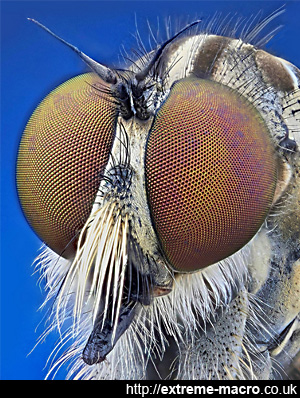Importance of Diffusion
by Johan J Ingles-Le Nobel
Last updated August 31, 2017
There are various reasons to use diffused light but top of my list in extreme macro is the multi directional nature of the light that it produces.
Diffused light is a highly scattered lightform, and with such a lightform it brings light to places that cause problems in photography because the dynamic range would be exceeded by using direct light.
Diffusion Confusion
Diffusion is a bit confusing because it can mean two different things. Firstly, how wide the angle the light spreads out as it leaves the flash, and also how wide an angle the light comes from as it reaches the subject. For macro photography, the result depends almost entirely on the latter, ie what the light looks like with respect to the subject. This most important of concepts is further explored here.
Winning the Shadows
Diffused light is a highly scattered lightformBecause of the multi directional nature of diffused light, high-end photographers use it because it creates soft, unnoticeable shadows. Diffused light wraps itself around an object and is more flattering than hard light.
When dealing with a hard direct light source, you would need to use flags barn doors to shape the light and keep it from falling off on objects that would create shadows. Diffused light can be there without causing harsh shadows and is a fast way to create outstanding work.
One of the most important things about light and diffusion takes a while to get your head around, but it is the principle of 'build then subtract'. With light, I always strive to have too much of it when I set out, then I will subtract light using all manner of flags, all the way down to using pieces of electrician's tape. The point is you can work with too much light to reduce it, but if you don't have enough then there's not a great deal that you can do about it. In truth this is not the easiest or quickest way to build your shoots, and benefits from continuous lighting rather than flash, but I profoundly believe that it is the better way and that it'll teach you more about light, and more importantly reading light, than any number of textbooks or forum gurus. Try it!
to a grain of rice placed in the centre, half of a pingpong ball is a massive diffuser arcing over half the known universeThere are many photographic situations that call for the use of soft light to reduce contrast between the shadows and highlights. Also it is the preferred form of light for people portraits as skin looks smooth and small blemishes become unnoticeable under soft light. The softer the skin of the subject the better it responds to diffused light.
Object Perspective Matters

Heavily diffused robberfly, using household objects.
Pingpong balls, yogurt pots, polystyrene cups, plastic milk bottles, piffle balls and plastic kitchen bowls all make superb low budget diffusers for the extreme macro photograph.
Add paper, tracing paper, paper kitchen towels and you've now got more or less everything you need to diffuse an indoor studio cheaply and nicely.
The absolute size of the diffuser does not matter. What actually matters is how much of the sphere surrounding the object to be photographed has diffuser over it. Ie, to a grain of rice placed in the centre, half of a pingpong ball is a massive diffuser arcing over half its entire universe.
What is really needed is a light source that covers a large arc from the perspective of the object being photographed. Thankfully this is quite straightforward because the object being photographed in extreme macro is very small.
Household Diffusers
Pingpong balls, yogurt pots, polystyrene cups, plastic milk bottles, piffle balls and plastic kitchen bowls all make superb low budget diffusers for the extreme macro photograph. Add paper, tracing paper, paper kitchen towels and you've now got more or less everything you need for an indoor studio. All sorts of diffusion tests here.
Related Articles



